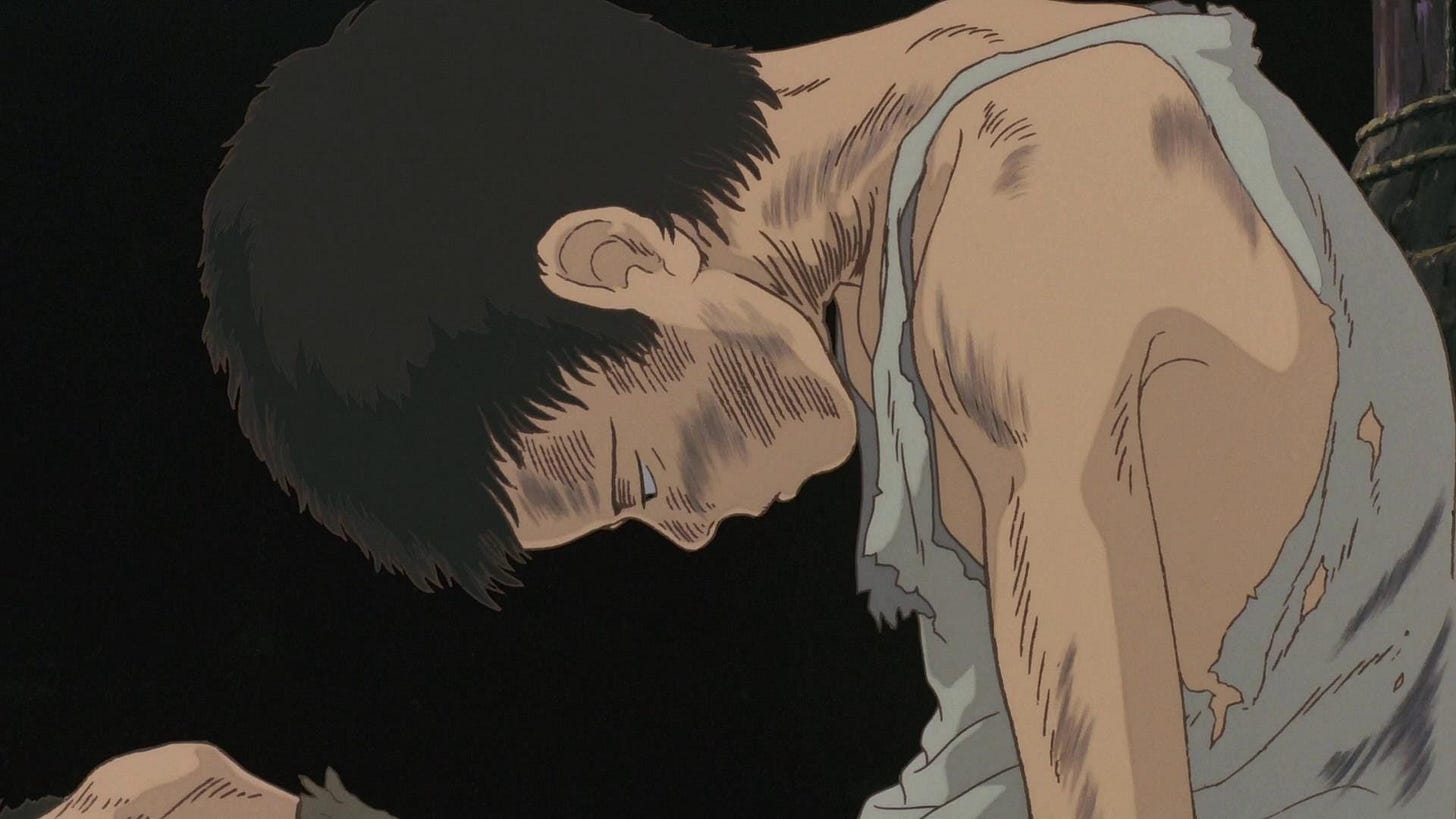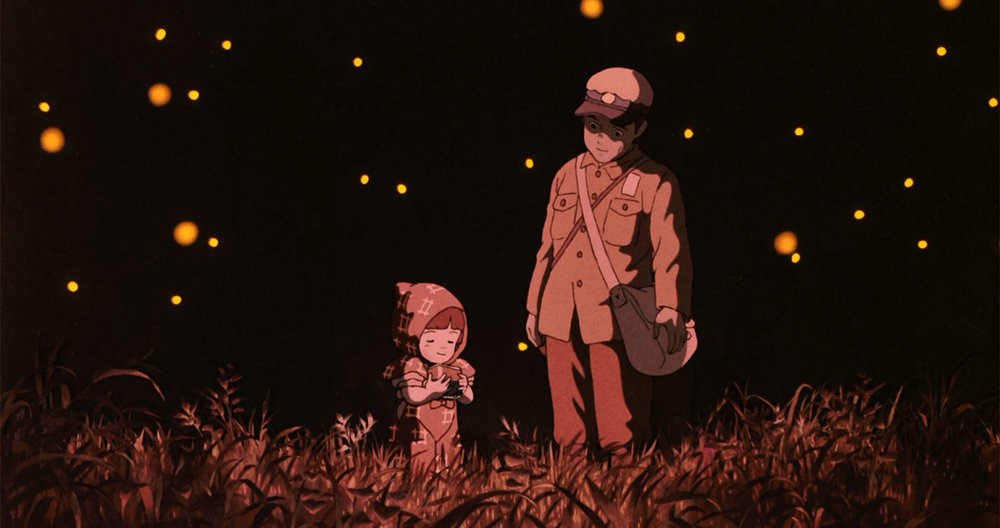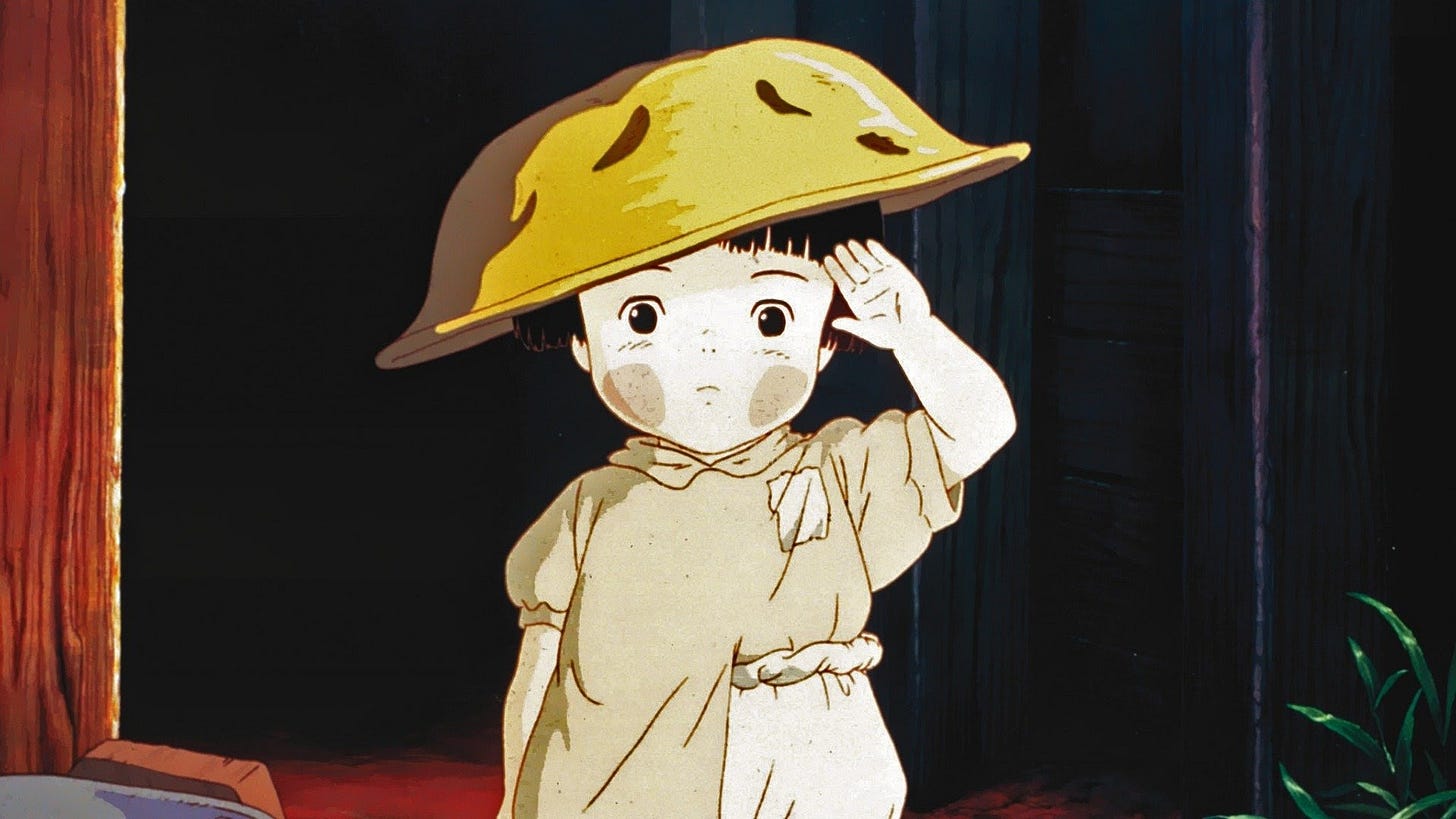Directed by Isao Takahata
Japan, 1988
The legend goes that no one had ever been moved to tears by an animated work until the night of December 21, 1937 and the world premiere of Snow White and the Seven Dwarves. The Disney animators themselves were reportedly shocked when—as Snow White lay in her bier—sniffles and then real sobs began to sound throughout the auditorium. “We couldn’t believe it. This was just a cartoon,” attrib. Ernest Rister
If you are a fan of the films of Studio Ghibli, films such as Spirited Away and Howl’s Moving Castle, but are yet to watch Grave of the Fireflies, be prepared for something very different. This haunting, quietly devastating work is not a children’s film. Grave of the Fireflies is a film about society, family, and conflict – a story of two Japanese children trapped in the cataclysmic ending of World War II. An anime yes, but also the most realistic and profoundly human of films.
The prologue itself is jarring: a boy sits on the floor of a railway station in dishevelled clothes. He is covered in filth, he looks exhausted…no, lifeless. And then the voiceover:
September 21, 1945... that was the night I died.
We flash back to months earlier. The boy, Seita, lives in the city of Kobe with his four-year-old sister, Setsuko, and their mother. Their father is away, he’s an officer in the Japanese Navy. US planes fly over the city, dropping incendiary bombs. A firestorm erupts and the children’s mother dies. The 14-year-old Seita (voiced by Tsutomu Tatsumi) is left in sole charge of his sister in a city where food is scarce and the fragility of the social structure is all too evident. They must do what they can in order to survive.
Initially they find shelter with an aunt and Seita tries to protect his sister from what’s going on – even keeping up a pretence that their mother is still alive. His relationship with their aunt is fraught. She accuses him of laziness:
You think a lazy slug like you deserves the same as people who are working so hard for our nation? Really Seita, you're certainly old enough to know that everyone has got to cooperate. You keep saying you want rice, but do you do anything to earn this rice you want? No you don't.
Eventually he takes his sister, Setsuko (voiced by Ayano Shiraishi), and they move to live in an abandoned bomb shelter. As the weeks pass by, he finds there is no more food to buy and resorts to theft. But this is not enough, and Setsuko grows weaker.
Grave of the Fireflies was written and directed by Isao Takahata, along with Hayao Miyazaki one of the co-founders of Studio Ghibli. He based the story on an autobiographical novel by Akiyuki Nosaka. Nosaka was a boy during the bombing of Kobe and his sister did indeed die of starvation. His life was for ever overshadowed by guilt.
The animation in this film is different from what you expect from Studio Ghibli, particularly the films of Miyazaki (Spirited Away). The backgrounds are painterly, akin to watercolour, and the faces of the characters are less well-defined, but somehow that allows them to be more expressive. This seeming simplicity is deceptive; this was unusual material for an anime, but the story is articulated in a way that could only have been a failure if attempted with live action and the inevitable use of CGI. Takahata follows the director Yasujirō Ozu with his use of ‘pillow shots’, cutting away to scenes of nature, which on the face of it appear random, but allowing for moments of reflection.
There is another contrast with the films of Miyazaki. Where we usually see his films through the eyes of a child, Grave of the Fireflies opens with the death of Seita and the story that follows is told in retrospect, watched over by the ghosts of Setsuko and Seita himself. Perhaps this is speaking to the Shinto tradition of ancestral spirits – Kami.
As you would expect from Studio Ghibli, there are images of real beauty in the film: the two children catching fireflies to illuminate their shelter, echoing the swirl of the green disco-ball lights we saw in Saim Sadiq’s Joyland. And then there are moments that will haunt you: Setsuko sucking on a marble, thinking that it is a fruit drop, or making ‘rice balls’ out of dirt.
Sorry to say but makers of three hour long films like Oppenheimer should be embarrassed… that someone else can make a film as powerful as this in under 90 minutes - C
Grave of the Fireflies clearly can be seen as a film that exposes the horror of war, and it is difficult to watch it now without being drawn to current world events, particularly in Gaza. Yet Takahata rejected that view: “the film’s not at all an anti-war anime and contains absolutely no such message.” The bombers fly overhead with little comment – they are almost abstract, and there is no mention of Hiroshima or Nagasaki. The film’s focus is on society and family: whether the ties that bind us are strong enough to withstand adversity. It has much in common, sharing a nuanced and ambiguous approach to its characters, with Michael Haneke’s post-apocalyptic film, Time of the Wolf.
Seita’s aunt seems harsh in her treatment of the two children, criticising Seita for reading comics and playing games when he should be helping with the war effort or working to find food. He sees his role as one of protecting his sister from the war – in essence, avoiding reality. At a time of mass starvation, he spends his money on a new oven just as the food is about to run out. The breakdown of his relationship with his aunt leads to them leaving her home, and in effect seals their fate. This is also a tale of naivety, pride and importantly, regret.
The film closes with a heartrending montage of Setsuko playing around the bomb shelter, while her brother looks for food. She is bursting with life, vitality, and innocence – a firefly. And then we cut to the two of them sitting on a bench atop a hill. It is night and they are looking at the lights of city, Kobe, now being rebuilt:
Seita: It’s time to sleep.
Setsuko: Okay.
In all of the Studio Ghibli films I have seen childhood is this magical place that comes to an end as eventually you have to grow up, and with Grave of the Fireflies it is the same. But here that ending is a muted cry of anguish - S
Reids’ Results (out of 100)
C - 85
T - 86
N - 85
S - 85
Thanks for reading Reids on Film. For all of those Ghibli groupies out there keep an eye on your inbox for a ReidsonFilm extra this week. If you enjoyed our review please share with a friend and do leave a comment.
Coming next … The Hitch-Hiker (1953)









Adding to my watch list! thanks :)